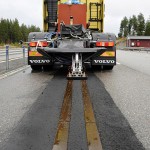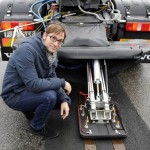Consider a future where trucks and buses are continuously supplied with electric power without carrying large batteries. Instead, power lines are built into the surface of the road. This could be a future solution for long-distance trucks and buses running on electricity.
The Volvo Group already has extensive knowledge about electric drivetrains, but in order to become world leading in sustainable transport solutions, the Volvo Group must find even more solutions that allow the vehicles to operate on renewable energy. A great deal of this energy will be distributed as electricity, but the challenge is all about supplying the vehicle with electricity power when needed.
“In city traffic, there are currently various solutions and we are researching many others. We have field tests in progress where our plug-in buses are equipped with a battery that can be charged quickly when the buses are at bus stops,”
Says Mats Alaküla, the Volvo Group’s expert on electric vehicles and Professor at Lund University.
But for long-distance trucks this will not work since they stop infrequently and to cope with this task they would need so many batteries that there would be no room for any cargo. Instead, a solution is required where power is continuously supplied to the truck from an external source.
The Volvo Group participates in a large Swedish research project to find solutions for this, with the support of the Swedish Energy Agency. The project includes the Swedish Transport Administration, Vattenfall, several universities, vehicle manufacturers and suppliers.
Last year, Volvo built a 400-metre long track at its testing facility in Hällered outside Gothenburg and the company has been testing the system since last autumn.
The method currently being developed and tested by the Volvo Group, together with Alstom, entails two power lines built into the surface of the road along the entire length of the road. A current collector in contact with the power lines will be located on the truck.
The two power rails/lines run along the road’s entire length. One is a positive pole, and the other is used to return the current. The lines are sectioned so that live current is only delivered to a collector mounted at the rear of, or under, the truck if an appropriate signal is detected. As an additional safety measure, the current flows only when the vehicle is moving at speeds greater than 60 km/h (37 mph).
“With this method, electric vehicles could be continuously supplied with power without carrying large batteries, the power line will be built in sections and one section is only live as the truck passes.”
Says Mats Alaküla.
“The vehicle is equipped with a radio emitter, which the road segments can sense,” explains Mats Alaküla. “If an electric vehicle passes a road segment with a proper encrypted signal, then the road will energize the segments that sense the vehicle.”
The truck being used as a test bed for the project is a standard Volvo FH12 tractor sporting a diesel engine. There’s no electric motor installed at the moment. When the collector comes into contact with the power lines, 750 V of direct current is delivered and routed to a water-cooled heating element that has a similar power requirement to an electrically-driven truck.
The collector has been designed to track the power rails, even when the vehicle is not directly over the middle of the contact lines.
“We are currently testing how to connect the electricity from the road to the truck. The electricity flows into a water-cooled heating element, with similar power requirement as an electricity-driven truck,”
Says Richard Sebestyen, who is the project manager at Volvo Group Trucks Technology, which is the Volvo Group’s research and development division.
However, a great deal of research still remains before this can become a reality. It involves the continued technical development of the current collector, electric motor and the control systems required. It also involves road construction, road maintenance, electricity supply along the roads and various payment models, etc. Mats Alaküla said,
“A lot of years remain before this is on our roads, but, if we are to succeed in creating sustainable transport systems, we must invest significantly in research now. I am convinced that we will find a cost-efficient way to supply electricity to vehicles in long-distance traffic and we have already come a long way in our research.”
Source; Volvo Trucks



